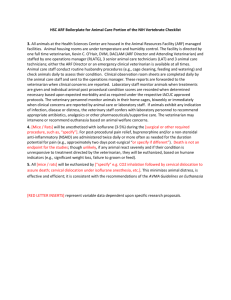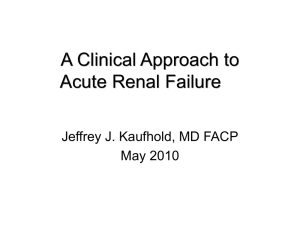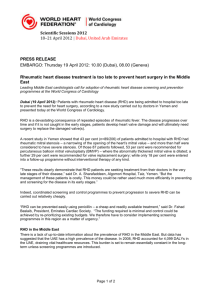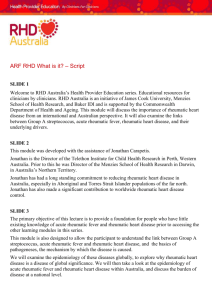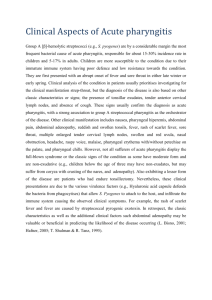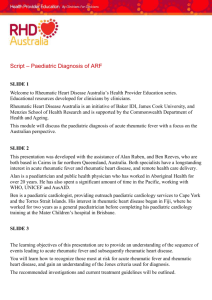Script (DOC) - RHD Australia
advertisement
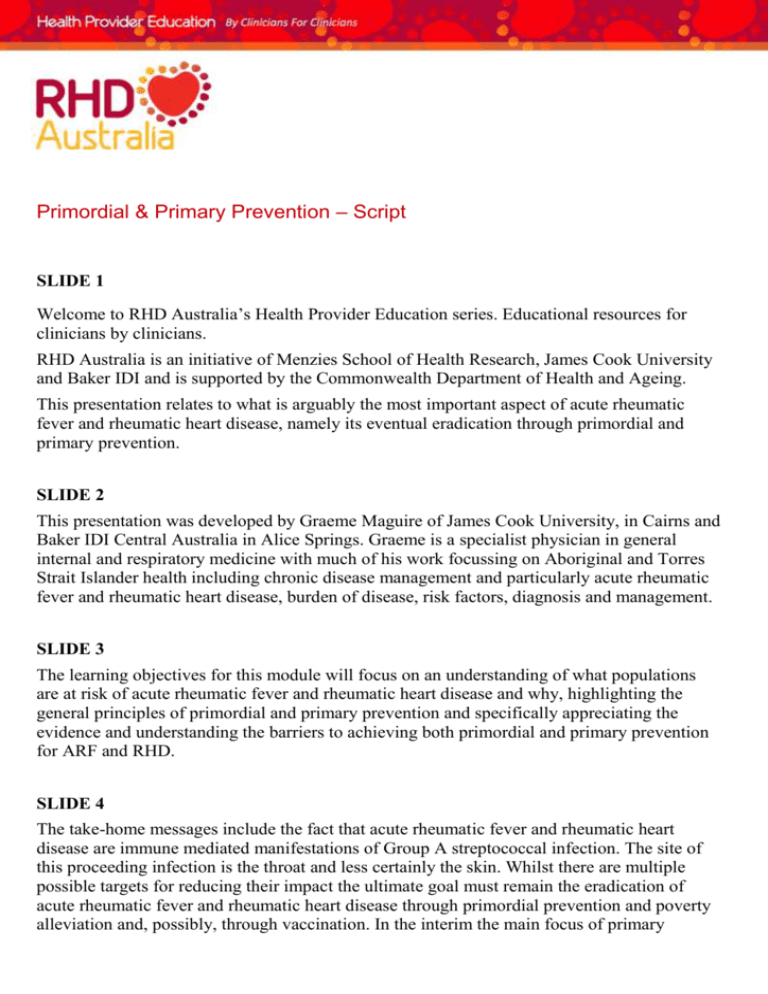
Primordial & Primary Prevention – Script SLIDE 1 Welcome to RHD Australia’s Health Provider Education series. Educational resources for clinicians by clinicians. RHD Australia is an initiative of Menzies School of Health Research, James Cook University and Baker IDI and is supported by the Commonwealth Department of Health and Ageing. This presentation relates to what is arguably the most important aspect of acute rheumatic fever and rheumatic heart disease, namely its eventual eradication through primordial and primary prevention. SLIDE 2 This presentation was developed by Graeme Maguire of James Cook University, in Cairns and Baker IDI Central Australia in Alice Springs. Graeme is a specialist physician in general internal and respiratory medicine with much of his work focussing on Aboriginal and Torres Strait Islander health including chronic disease management and particularly acute rheumatic fever and rheumatic heart disease, burden of disease, risk factors, diagnosis and management. SLIDE 3 The learning objectives for this module will focus on an understanding of what populations are at risk of acute rheumatic fever and rheumatic heart disease and why, highlighting the general principles of primordial and primary prevention and specifically appreciating the evidence and understanding the barriers to achieving both primordial and primary prevention for ARF and RHD. SLIDE 4 The take-home messages include the fact that acute rheumatic fever and rheumatic heart disease are immune mediated manifestations of Group A streptococcal infection. The site of this proceeding infection is the throat and less certainly the skin. Whilst there are multiple possible targets for reducing their impact the ultimate goal must remain the eradication of acute rheumatic fever and rheumatic heart disease through primordial prevention and poverty alleviation and, possibly, through vaccination. In the interim the main focus of primary prevention should be appropriate management of pharyngitis especially in high risk populations and possibly addressing skin disease. SLIDE 5 Before proceeding further, it is worthwhile defining the terms and abbreviations that will used. Acute rheumatic fever is often termed ARF. This is a nonsuppurative complication of Group A streptococcal infection, a common bacteria found in the throat and on the skin. In susceptible individuals, and particularly children, immune mimicry results in inappropriate cross reactivity between streptococcal and patient tissue antigens particularly those associated with joints, skin, brain and, most importantly here, the heart. This results in immune mediated inflammation of the heart and particularly the heart valves termed carditis. Rheumatic heart disease, or RHD, is the chronic sequelae of ARF and particularly recurrent episodes of ARF. Recurrent carditis with valve inflammation leads to scarring and distortion of these valves and eventually dysfunction. This can include stenosis, with the valve not opening correctly, or regurgitation, with the valve leaking. ARF and RHD has a particular predilection to the valves on the left side of the heart, namely the mitral and aortic valves. As highlighted, ARF and RHD are a complication of a common bacteria called Group A beta haemolytic streptococcus. This bacteria, otherwise known as ‘G’ ‘A’ ‘S’ or GAS, is a cause of approximately twenty to forty per cent of cases of symptomatic pharyngitis or sore throat. It is GAS-related pharyngitis which is thought to be the major driver of ARF. Whether GAS associated with skin sore or pyoderma can also lead to ARF remains controversial. Reassuringly GAS remains universally susceptible to penicillin and benzathine penicillin G, or BPG, remains the most effective antibiotic for both the prevention and management of GAS pharyngitis. SLIDE 6 For those who would like more information regarding the primordial and primary prevention of ARF and RHD this can be found in the Australian Guidelines for the Prevention, Diagnosis and Management of ARF and RHD. These guidelines have been substantially updated and revised in 2012, are available at the RHD Australia website. Most of the information presented here is outlined in more detail in primordial and primary prevention chapter. SLIDE 7 A quick reference guide is also available, which provides an excellent summary. SLIDE 8 More information regarding other aspects of the prevention, diagnosis and management of acute rheumatic fever and rheumatic heart disease can be found at the RHD Australia website in the health provider education modules. These will be regularly updated and expanded. SLIDE 9 Before proceeding further a few basics factors regarding ARF and RHD pathophysiology are worthwhile reinforcing. These include, that only three to six per cent of a population are susceptible to ARF. The risk of ARF also appears to greater in girls and women, as compared to boys and men, and this in turn results in more rheumatic heart disease in women. Exactly why this is the case remains unclear. Potential explanations may be greater exposure to GAS bacteria through childcare, a greater diagnosis of disease because of greater access to health care or a female preponderance to autoimmune disease which is also seen with other conditions such as lupus or SLE. Essentially we don’t know. There are also genetic associations which can mean that the risk of ARF and RHD can be higher in particular families. Nonetheless there is no clear and consistent genetic marker that allows the accurate identification of the small proportion of people who are at risk of developing ARF in any given population. Importantly there is no good evidence that there is a racial pre-disposition to ARF and RHD. Aboriginal and Torres Strait Islander peoples are no more susceptible to these conditions then other people per se. Rather the factors driving greater exposure to more diverse populations of GAS is likely to be the key factor that explains the greater burden of disease borne by Aboriginal and Torres Strait Islander people in Australia and for other populations faced with similar environmental, social, educational and economic disadvantage. SLIDE 10 So in summary ARF is a nonsuppurative complication of GAS pharyngitis and perhaps skin disease. There is an exaggerated and misdirected immune response, such that the patient’s own immune system, two to three weeks following an episode of GAS infection, is mistakenly directed at the joints, skin, brain and heart. SLIDE 11 The greater the number of episodes of ARF, the more likely a person will develop irreversible valve damage and thus RHD. The key to primordial and primary prevention is to stop GAS infection occurring or, if it does, stop this leading onto ARF and RHD. Once an the first episode of ARF has occurred, subsequent management is focused at secondary and tertiary prevention, areas which will be addressed in greater detail in other modules of this RHD Australia Health Provider Education Program. SLIDE 12 With this summary of ARF and RHD development in mind we will now focus more specifically on prevention. Prevention is the process whereby interventions are implemented to prevent the development, progression or complications of a particular disease. It can be most easily conceptualised as an inverted pyramid, where primordial prevention is the most important factor, followed by primary, secondary and tertiary prevention. SLIDE 13 Today’s presentation will concentrate specifically on primordial and primary prevention. SLIDE 14 So let’s begin with primordial prevention. Primordial prevention focuses on the population at risk. But what does this mean? SLIDE 15 Primordial prevention was a term first coined by Tom Strasser from the World Health Organisation in 1978. It is a simple extension of the concept of primary prevention. In this case, rather than identifying and addressing individual risk factors, in this case GAS infection, primordial prevention aims to prevent the development disease by stopping a population being exposed to risk factors in the first place. SLIDE 16 In the case of ARF and RHD primordial prevention can be viewed as broad, social, economic and environmental initiatives undertaken to prevent or limit the impact of GAS infection in a population. And what do we mean by population? Well in the case of ARF and RHD, primordial prevention means initiatives that focus on populations, communities, families and households, rather than individuals. SLIDE 17 So the question regarding primordial prevention is what is it that is driving the presence of and exposure to GAS infection in populations at risk of ARF and RHD? SLIDE 18 One way to conceptualise this is to look beyond Aboriginal and Torres Strait Islander people today and back to non-indigenous Australians a hundred years ago. At this time, at the turn of last century, acute rheumatic fever was a major contributor to health care utilisation and hospitalisation of children. At this time in Australia, similar environmental and social factors that are faced by Aboriginal and Torres Strait Islander people both in a remote and urban settings were faced by many non-indigenous Australians. These included household overcrowding, economic and education disadvantage and poor access to infrastructure required to maintain health and hygiene. These images of the tenements of Carlton in Melbourne demonstrate the broad range of issues that were likely driving exposure to GAS infection and ARF in this population. Small and cramped homes, overcrowding, outdoor toilets, an unreliable water supply, unemployment and limited educational opportunities were all likely factors contributing to the fact that half the beds in paediatric hospitals in non-indigenous Australia were occupied by children with ARF and other complications of GAS infection. SLIDE 19 Many Aboriginal and Torres Strait Islander people are faced with similar issues relating to household overcrowding, household quality, and economic, social and educational disadvantage. But the question is, what aspects of environment are important and is there sufficient evidence to focus on one particular aspect of environment over another as a target for primordial prevention of ARF and RHD? SLIDE 20 Many Aboriginal and Torres Strait Islander people, particularly those in remote Australia, have the additional burden of remoteness, with its attendant impact, not just on health care access, but also on economic sustainability and education. Despite this there remains no good evidence that addressing any one of these factors will, by itself, successfully lead to the primordial prevention of acute rheumatic fever and rheumatic heart disease. SLIDE 21 So where does this leave us? There remains a clear link between disadvantage and the risk of ARF at a population level, not only for Aboriginal and Torres Strait Islander people, but for people in any other setting. Thus, if we are to talk about the primordial prevention of ARF and RHD we need to advocate to address economic, social and environmental disadvantage, which will, as it did for non-indigenous Australians, largely eradicate ARF and RHD. Nonetheless, it is not possible to advocate for any one specific targeted intervention. Rather a broad, whole of government, whole of society response to addressing disadvantage will eventually eradicate ARF and RHD as it did for non-indigenous Australian’s. SLIDE 22 So let us now move onto primary prevention. SLIDE 23 It has already been highlighted that the primary prevention of ARF and RHD particularly relates to GAS infection. SLIDE 24 In turn there are two targets for addressing GAS infection. The first relates to stopping GAS infection in the first place, preventing someone from getting infection whilst the second target is the early treatment of GAS infection before it can lead onto ARF. We will discuss both of these targets in the coming slides. SLIDE 25 Whilst there is a clear association between GAS pharyngitis and ARF it should be noted that in outbreak investigations of acute rheumatic fever in the United States, only one third of children reported a prior episode of symptomatic pharyngitis. Therefore, whilst proceeding pharyngitis is a clear precipitant of ARF it is also clear that many people who have ARF do not have a prior sore throat. Whilst ARF is not invariably associated with symptomatic pharyngitis, this does not in itself mean that GAS infection and a subsequent misdirected immune response is not playing a role. Rather it is likely that GAS infection in the throat associated with a host immune response may, in many people, cause mild or no symptoms. The situation for GAS infection involving the skin or pyoderma remains unclear. While it has been suggested that skin disease related GAS infection may be a driver of acute rheumatic fever, particularly in the northern Top End of the Northern Territory the evidence for this is far from conclusive. Nonetheless whilst it is not possible to definitely say that GAS infection of the skin is a driver of ARF in an Australian remote and Indigenous setting, or in any other setting, this is certainly an area worthy of further study. SLIDE 26 So how do we stop people from getting GAS infection in the first place? We’ve already highlighted the importance of primordial prevention. To reinforce it is primordial prevention which is the key to stopping people getting GAS infection but, as we have already highlight, it is unclear exactly what aspect of environment is playing a role here. Nonetheless a broad, whole-of-society, whole-of-government approach to addressing poverty and disadvantage remains key. The two other potential targets to stop people developing GAS infection and thence ARF are first the use of prophylactic antibiotics in populations at high risk of GAS infection and particularly GAS associated pharyngitis and ARF and second – a vaccine directed at GAS. As regards prophylactic antibiotics there is clear evidence in studies of reasonable quality that these have been shown to effective primary prevention in both stopping GAS pharyngitis and the development of ARF. Whilst prophylactic antibiotics as primary prevention in people who do not have a history of ARF or RHD is effective it is unlikely, at a population level, that they would be a sustainable initiative. Vaccination, however, remains the holy grail of primary prevention. To have an intervention which provides ongoing protection against the acquisition of GAS infection would, whilst we await primordial prevention to be effective, provide the greatest hope in the short term for largely eradicating ARF and RHD. Whilst we don’t have an effective vaccine as yet these are in development. We will now outline these two target for primary prevention in greater detail, namely prophylactic antibiotics and vaccination. SLIDE 27 As regards prophylactic antibiotics in populations at high risk of GAS infection and ARF, most of what we know we owe to the American military and their induction or ‘boot’ camps for training soldiers. During World War 2 when large numbers of people were being crowded into training camps prior to deployment to war it became apparent that there was an increasing rate of ARF in these predominantly young men. SLIDE 28 In this setting it was demonstrated that if all training solders were administer with long acting penicillin, in this case benzathine penicillin G or BPG, then episodes of GAS related pharyngitis were greatly reduced with an attendant reduction in the incidence of ARF. Therefore, from these studies, it was apparent that in a population at high risk of GAS pharyngitis and ARF, this risk could be dramatically reduced by using antibiotics pre emptively before people has even developed GAS pharyngitis. SLIDE 29 So what does this mean? Well what it does demonstrate is that prophylactic antibiotics prevent acquisition of GAS and the development of ARF. However, it is only likely to be sustainable for intermittent use in a population at short-term elevated risk, in this case, army recruits entering boot or training camp. It is unlikely that regular use of prophylactic antibiotics at a population level in Aboriginal and Torres Strait Islander populations, without a history of ARF and RHD is likely to be sustainable or effective or acceptable. Whilst more focused use in the small proportion of people who are susceptible to ARF in any given population may be more sustainable we have already highlighted that identifying such people accurately remains impossible. SLIDE 30 So this brings us to the key role of vaccination and the need to prioritise vaccine development as a shorter-term solution to ARF and RHD eradication. The most attractive feature of vaccination is that it is longer lasting and does not require regular dosing. Nonetheless progress towards an effective vaccine has thus far been disappointing. Whilst we do not yet have an effective vaccine for GAS a more detailed understanding of the aspects of vaccines under development is still useful. SLIDE 31 In this case there are two main vaccine targets for GAS. Those include the non M protein vaccines which are directed against other aspects of the GAS bacteria. Whilst many of these have shown promise in laboratory studies none has been demonstrated to be effective in clinical trials. More encouraging has been the development of M protein vaccines, the major factor that allow GAS to cause infection and disease. The most promising at the moment is a multivalent vaccine based on a particular part of the M protein called the amino terminus but clinical trials to demonstrate its effectiveness is still pending. Whilst any vaccine that is developed will need be active against the local GAS M protein types in our region this provides an area for cautious optimism to allow facilitate the primary prevention of GAS infection and ARF and RHD in our and other settings. SLIDE 32 So where are with vaccinations and what do they mean for us? Well certainly the development of an effective vaccine should remain a priority. Currently the most promising are M protein-based vaccines but we are still awaiting clinical trials to demonstrate their effectiveness. Even if an M protein vaccine is shown to be effective it will also be important that this reflect the local M protein sub-types that we are faced with in our community. This is certainly a reason to continue to examine the local diversity of GAS and the role of GAS in both throat and skin infection particularly for Aboriginal and Torres Strait Islander people. Certainly a case of ‘watch this space’. SLIDE 33 Which brings us to the final area of ARF primary prevention that we will address, namely the management of GAS infection once it has occurred but before it has the opportunity to cause ARF. Again much of what we know in this regard we owe to the American military and their World War 2 boot camps. In this setting the treatment of GAS confirmed pharyngitis was demonstrated to prevent the subsequent development of ARF. Indeed, later studies showed that if antibiotics were delayed for 9 days after the onset of symptoms they remained effective in preventing the subsequent development of ARF. Of note was the fact that this was irrespective of whether the individual had mounted an antibody response to the GAS infection. Thankfully GAS remains universally sensitive to penicillin and so the argument can be made that in high risk populations there should be a low index for treating symptomatic pharyngitis with antibiotic. SLIDE 34 Nonetheless as noted earlier, not all episodes of ARF are associated with pharyngitis and thus even treating all people with symptomatic GAS pharyngitis will not, in itself, eradicate ARF and RHD. So how do we approach pharyngitis in a population at high risk of ARF and RHD? Certainly we know that only 20-40% of cases of pharyngitis are due to GAS. Whilst it would be preferable to treat only those with pharyngitis confirmed to be associated with GAS infection this is not always possible. Clinical scoring systems have been developed which aim to differentiate GAS from non-GAS pharyngitis and thus limit antibiotic treatment to only those with GAS related disease. Nonetheless in the real world, in high risk populations these lack both sensitivity and specificity thus meaning many people are treated unnecessarily whilst missing many others who have GAS-related pharyngitis. Rapid antigen detection tests, or RADTs, aim to provide a point of care diagnosis of GAS pharyngitis in someone presenting with pharyngitis. These however have been similarly disappointing though there is ongoing development hopefully of more sensitive and specific tools. For now culture is likely to remain the gold standard of the diagnosis of GAS related pharyngitis. SLIDE 35 So what do we do in this setting of a lack of a perfect readily available diagnostic tool and the fact that all cases of pharyngitis are not related to GAS? Two strategies present themselves in populations at high risk of ARF and RHD. The first is to accept that there will be, by nature, overtreatment and to treat all patients presenting with symptomatic pharyngitis particularly those at highest risk of ARF, namely children between the ages of 5 and 14. In this case, we must accept that there will be approximately 60% of children unnecessarily treated with antibiotics. This is also a far-from-perfect tool since it is clear that only approximately one third of people have symptomatic pharyngitis prior to an episode of ARF. Whilst it will not lead to the eradication of ARF it may reduce its rate. The other approach in high risk populations where follow up can be assured, is to perform a throat swab and provide treatment only to those with GAS confirmed on throat swab. To be effective this approach requires successful follow-up of the patient and treatment within nine days of onset of symptoms. Given symptoms of a sore throat may have resolved by the time the need for antibiotics is confirmed it is understandable that many people may refuse treatment as they now consider themselves to be well. SLIDE 36 And what of skin disease? SLIDE 37 There is no good evidence that preventing skin infection or treating GAS related pyoderma prevents ARF. Nonetheless, a lack of evidence is not necessarily evidence of a lack of effect. In remote Aboriginal communities skin health programmes have been demonstrated to prevent skin disease and are likely to improve quality of life. Whilst it is therefore reasonable to support any initiative which directs an evidence-based approach to improving skin health at present, without further evidence, it cannot be said that this will in turn reduce the risk of ARF. Further research remains a priority. SLIDE 38 So in conclusion, how does what has been presented inform clinical practice in the world where you live? Primordial prevention and primary prevention, in the form of a vaccine, must remain a priority. Nonetheless at present evidence lacking regarding how to implement either of these. Prophylactic antibiotics in those without a history of ARF or RHD but in populations at high risk are effective but this is not sustainable in the long term. GAS-associated pharyngitis is clearly associated with ARF in susceptible individuals but many people with ARF do not have a history of pharyngitis. Nonetheless, two strategies present themselves for high risk populations, namely, using antibiotics in all people in high risk populations who present with pharyngitis or, if diagnosis and follow up can be assured, performing a throat swab and treating only those with confirmed GAS within 9 days of symptom development. Exactly where skin disease fits into this mix remains unclear but is certainly a priority for further study. SLIDE 39 To return to our take home messages: 1. ARF and RHD are immune mediated manifestations of GAS infection 2. the site of the preceding GAS infection is classically the throat and possibly the skin 3. the ultimate goal must be primordial prevention which has worked in other populations and can work in high risk Australian populations including for Aboriginal and Torres Strait Islander people. 4. In the interim, primary prevention and particularly primary prevention through the development of an effective vaccine is likely to present a shorter term solution. 5. Nonetheless until we have an effective vaccine primary prevention will consist of treating symptomatic pharyngitis with antibiotics in high risk populations SLIDE 40 If you would like to know more about ARF and RHD please refer to the new Australian guidelines. Further education modules are available at the RHD Australia Health Provider Education website. SLIDE 41 You can also register at the Health Provider Education website for additional resources to download this and other power-point presentations for your own use in your local practice and additional assessment items for training providers. And if you would like to be notified about new modules and updates, please ‘Like’ us on Facebook at the provided below. SLIDE 42 And finally, for those of you who would like to test your knowledge regarding the information presented in this module please go to the brief self-assessment quiz at the link provided on this website. SLIDE 44 Finally thank you for your time in learning a little more about the primordial and primary prevention of acute rheumatic fever and rheumatic heart disease.
